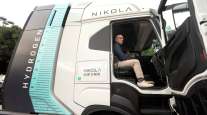Senior Reporter
Nikola Sets Truck Production Schedule, Envisions Autonomous Model

[Ensure you have all the info you need in these unprecedented times. Subscribe now.]
Zero-emission truck maker Nikola Corp., which recently jumped to a publicly traded company from its startup perch, has begun building prototypes of its heavy-duty battery-electric model in Germany and is set for groundbreaking on a plant in the United States this summer.
Farther out, Nikola sees its longhaul models operating autonomously if needed.
Nikola will build and sell the battery-electric trucks in Europe, exporting some to the U.S. market, with production scheduled to begin in 2021. Hydrogen fuel cell trucks aimed at the longhaul market will come next, and will be made in Europe and the United States.

COVID-19 has placed significant strain on many freight networks. So how are third-party logistics providers adapting to meet these challenges? Host Seth Clevenger chats with two 3PL executives who have had firsthand experience contending with this crisis. Hear a snippet, above, and get the full program by going to RoadSigns.TTNews.com.
Nikola is using the S-Way platform from European truck maker Iveco as the basis for its trucks. Iveco is now selling the S-Way model with either a diesel or natural gas engine.
“The S-Way is maybe the last heavy-duty diesel vehicle that is designed to be introduced in the world. The Iveco S-Way came out last year in July. There’s not too many more people who are going to introduce diesel vehicles in the future. And that may be one of the last ones,” Nikola CEO Mark Russell said during an online presentation at the Deutsche Bank Global Auto Industry Conference June 10.
Russell said no orders have been taken yet for the Nikola Tre, the battery-electric model with a range of 300 miles, “but we will.”

Russell speaks at a past company event. (Nikola Motor Co.)
The presentation noted discussions with potential customers for the Tre model have focused on thousands of preorders with binding contracts, with significant deposits 12 months prior to delivery.
“What’s new about Nikola’s adaptation of the S-Way is the electronics, the software, control systems and especially the batteries, the fuel cell, e-axles and drivetrain. That’s the secret sauce,” Russell said.
The U.S. plant coming to Coolidge, Ariz., will be able to build on the same line as both the Nikola Tre and the eventual heavy-duty hydrogen fuel cell model, he said.
Production of the hydrogen fuel cell longhaul truck is scheduled for 2023 and dependent on creating the necessary fueling infrastructure.
When you are making hydrogen for fueling stations out of water, using electrolysis, up to 90% of the cost is a function of the cost of electricity that serves as a catalyst, Russell said. “If we can get 2-cent electricity we can probably make hydrogen for $2 a kilo cash cost. A kilo of hydrogen has about the same energy equivalent as a gallon of diesel fuel. So $2 a gallon is a pretty good price. It’s more complicated than this of course but that’s the basic math of how it works,” he said. “That is competitive with diesel. That gave us the confidence to go to the market with the bundled lease.”
Under Nikola’s lease plan — available only with a hydrogen fuel cell truck — a fleet pays a set monthly price over seven years or 700,000 miles for the truck, all fuel and any needed service.
Nikola’s plan aims to attract fleets operating on dedicated routes and it will place its hydrogen fueling stations on each end of such a route. Its hydrogen fuel cell truck will have a range up to 750 miles. The hydrogen fueling stations also will provide charging stations for battery-electric vehicles and be open to the public.
Nikola stopped taking orders for the fuel cell truck after getting 14,602, selling out the first few years of production. They all will have automatic braking and lane-keeping technology, fleet management solutions and data capturing, and receive over-the-air software updates.
“We are designing these trucks so they will be autonomous capable. The first generation will not be autonomous, but have the hardware to [SAE] Level 4 so that when autonomous software catches up and regulations get to where they need to be, we will be able to make these trucks autonomous very seamlessly,” Russell said.
Want more news? Listen to today's daily briefing:
Subscribe: Apple Podcasts | Spotify | Amazon Alexa | Google Assistant | More




